The key ingredient in the jelling of American popular music in the nineteenth century was the minstrel show. Traveling troupes of White musicians brought a smorgasbord of cultural influences to small towns and plantations from the early 1800s into the next century. Borrowing, stealing, humiliating, and remixing, they created the first secular music that was truly American.
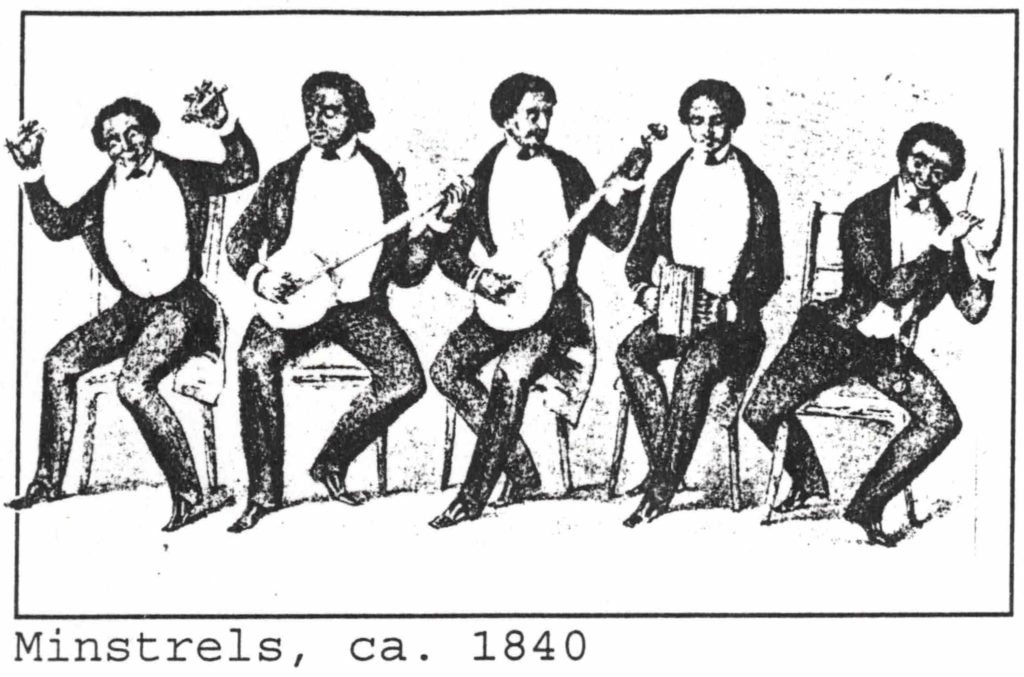
Many of the early minstrels were Irish or Scots-Irish. Many thousands of Irish people had been displaced by English conquest, and Scots had been cleared from their highlands to be replaced by sheep. Later, thousands of Irish fled the famine of the 1840s; in great numbers they came to America. The Irish were an economically and culturally marginal group,[1] and the populace at large found their songs and accents amusing, as they would come to find Black culture, as purveyed by the Irish. The Irish held a special underclass status in America, in keeping with their colonized status back at home. Many convicts and prisoners of war had been sent from Ireland to Jamaica (as well as to Australia and elsewhere) after 1664 as indentured servants. One of their roles there was to guard against Black rebellions. Intercourse ensued; among the Black musicians with Irish ancestry are Jimi Hendrix and Bob Marley.
[1] No Irish needed apply to many occupations,
which drove them into disreputable pursuits
such as show business and police work.
Meanwhile, some of the best singers of Irish dialect songs in the 1870s were said to be Black stevedores in Ohio.[i] The interplay was endless: an old Irish folk tune—or was it a frontier fiddle tune? or both?—became “Zip Coon,” a song that fostered an enduring stereotype of a pretentious Black dandy; the same song with its lyrics removed became “Turkey in the Straw.”[ii] In Chicago in 1870 an Irish/coon caricature duo was a big hit.[iii]
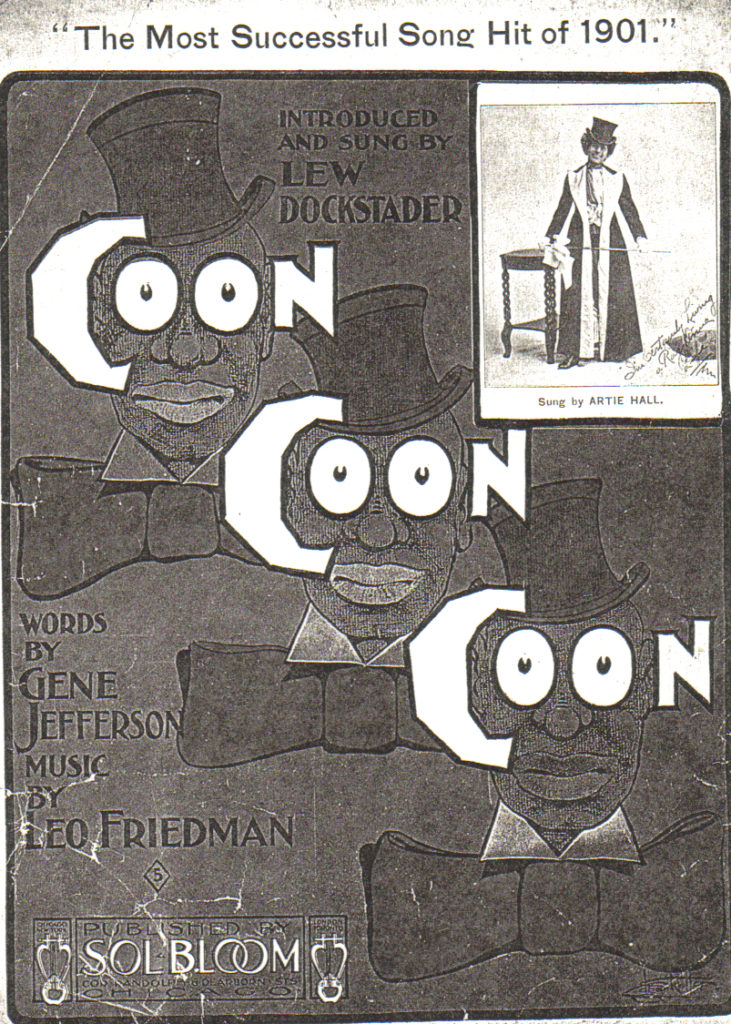
American minstrels brought new instruments to the British Isles: tambourine, bones, banjo. Meanwhile English performers also had an influence on minstrelsy: British troupes toured the U.S., blackface and all, from about 1822. Many of the British minstrels were Cockneys—lower class Brits entertaining by imitating lowest class Americans.
One Cincinnati day[2] in 1828, a minstrel named Thomas “Daddy” Rice happened upon an old Black groom named—well, we don’t know his name, of course—but as he went about his work he was singing and dancing a little number:
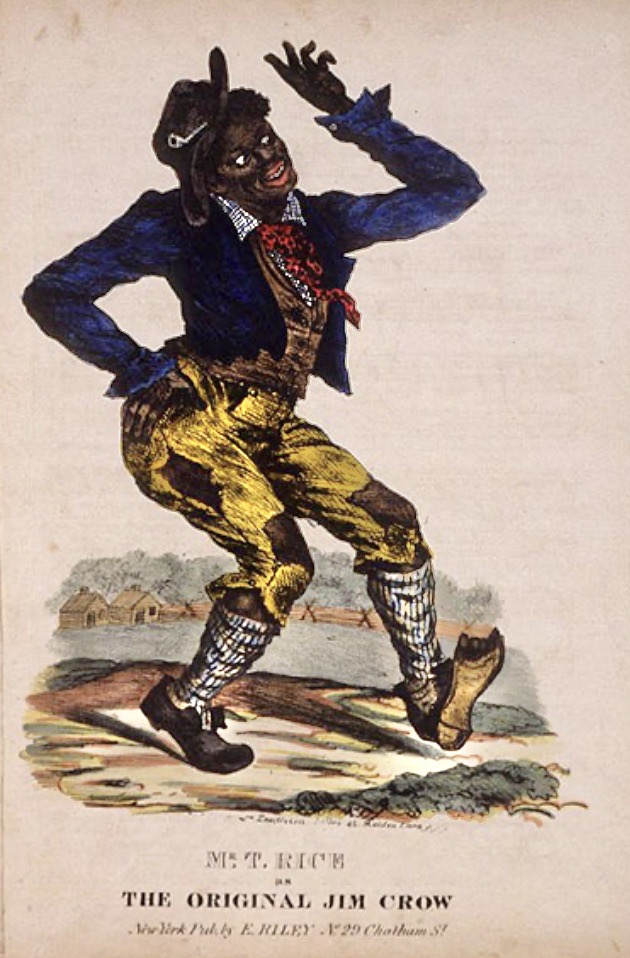
Turn about and wheel about and do just so,
And every time I wheel about I jump Jim Crow[3]
[2] or Louisville; historians don’t know for sure.
[3] From a lyric in a (borrowed) minstrel tune,
possibly referring to a dance in imitation of a bird,
possibly used in plantation corn shucking frolics,
Jim Crow would go on to become synonymous with
segregation laws.
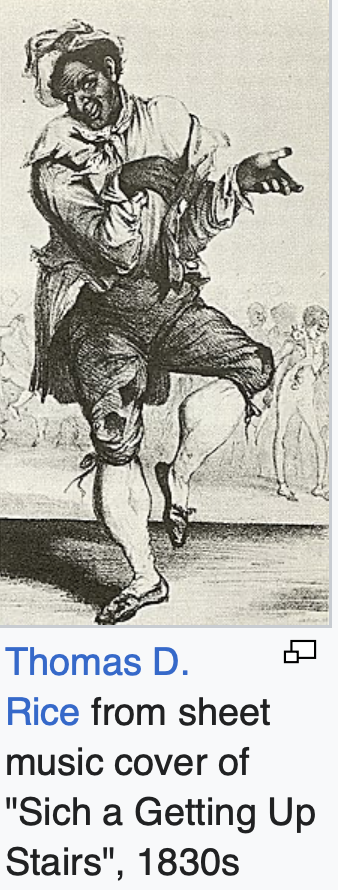
Rice pursued the artiste, copped the riff, blacked his face, and out popped a hit. The old fellow who caught his performer’s eye was not only Black but also physically afflicted, or at least possessed by rheumatism, and thus his movements were not only exotic but peculiar—today we would call the imitation “victim humor.” In any case, the new bit was a smash, and it changed show business, not unlike an early-day Twist.[4]
[4] Ten years later Rice would add a skit
based on a song done by a New Orleans street vendor
called Mr. Corn Meal, after a song he did
about the Indian corn he sold.
(Conway 1995, 92, 327)
Other minstrels took notice. Performers from the South visited plantations—if they didn’t live on them themselves – and were swept away by the artistry of those in bondage. The largest part of the resulting material was an imitation of the plantation entertainments, including the song and dance styles. A contemporary observer recalled a plantation festival in Virginia as being full of “laughter and song, antics and buffoonery which would make a modern minstrel show appear tame…”[iv] Having Pat Booned or Vanilla Iced it down a bit, the promoters gave their shows names such as “Plantation Revels” and “Plantation Frolics.” The shows customarily ended with a cakewalk, just as actual plantation revels did.
As the nation was a diverse stew of peoples, if not a melting pot, so with the music. John Rublowsky describes minstrel music as “an Anglo-American modification of an Afro-American modification of African, English, Scotch, Irish, German, French and Spanish originals.”[v]
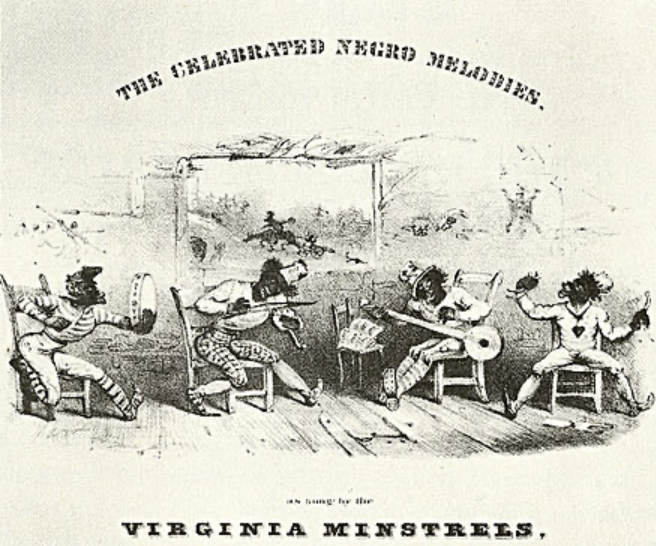
In this connection, Old Dan Tucker can help guide us back through the mists of time and shed some light on the mysteries of cultural origins. Most of us think of Dan in connection with an amusing square dance tune, but let’s hit the roots trail. The song was scribbled by Dan Emmett of the Virginia Minstrels around 1830, and was blown up into a skit with Dan playing Dan, White playing Black. The humor was the usual minstrel mix; today’s bleached version retains the humor while covering the tracks of its tears. Take a look at the sheet music of the day to see where folks got their entertainment. Emmett’s other tunes included “I’m Gwine Ober De Mountains” and “The Fine Old Colored Gentleman.”
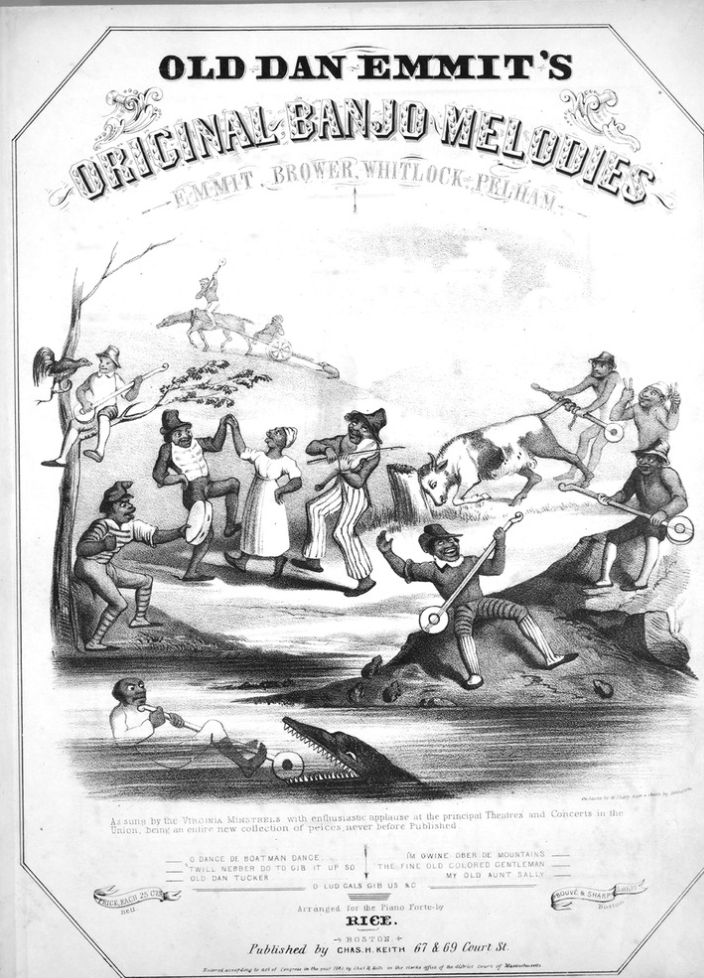
The arts of this period were characterized by gross caricatures of ethnic groups—something that has been, more or less, diminishing with time. All kinds of groups came in for stereotyping, most of all the lowest of the low. Minstrelsy often portrayed Blacks as lazy, cowardly and stupid; yet at other times their characters were witty and talented. The “lower” Black characters, Tambo and Bones—named for their musical instruments—were the customary winners in the tricky and sophisticated punning contests, beating the supposedly superior “interlocutor” (MC) and the audience as well.[vi] Their rattling instruments told the audience it was time to laugh, and constituted perhaps the first laugh track, or at least cue card.[vii]
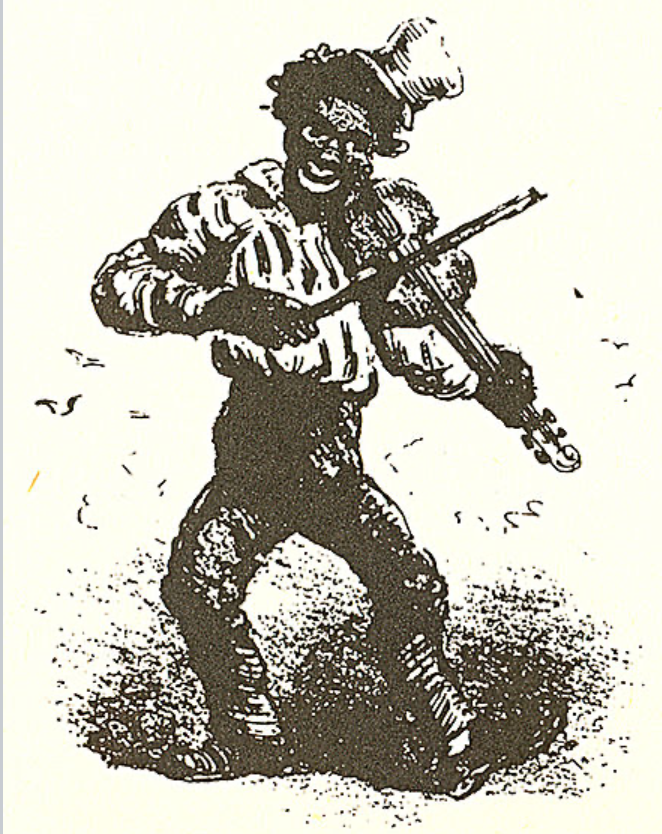
And there were instances of outright reversal of racial stereotypes, including one story in which Cain and Abel were Black, with Cain turning white in fear of God after murdering his brother. Another story has Adam and Eve turning white in fear of God after their own transgression.[viii]
The standard critique of minstrelsy is that it was pure racism on the stage. But William F. Stowe and David Grimsted critiqued the critique by exposing the multiple functions of the form: the White performers were making fun of Blacks, but at the same time identifying with them, or at least with their idea of them. “White men put on black masks and became another self, one which was loose of limb, innocent of obligation to anything outside itself…and thus a creature totally devoid of tension and deep anxiety.”[ix]
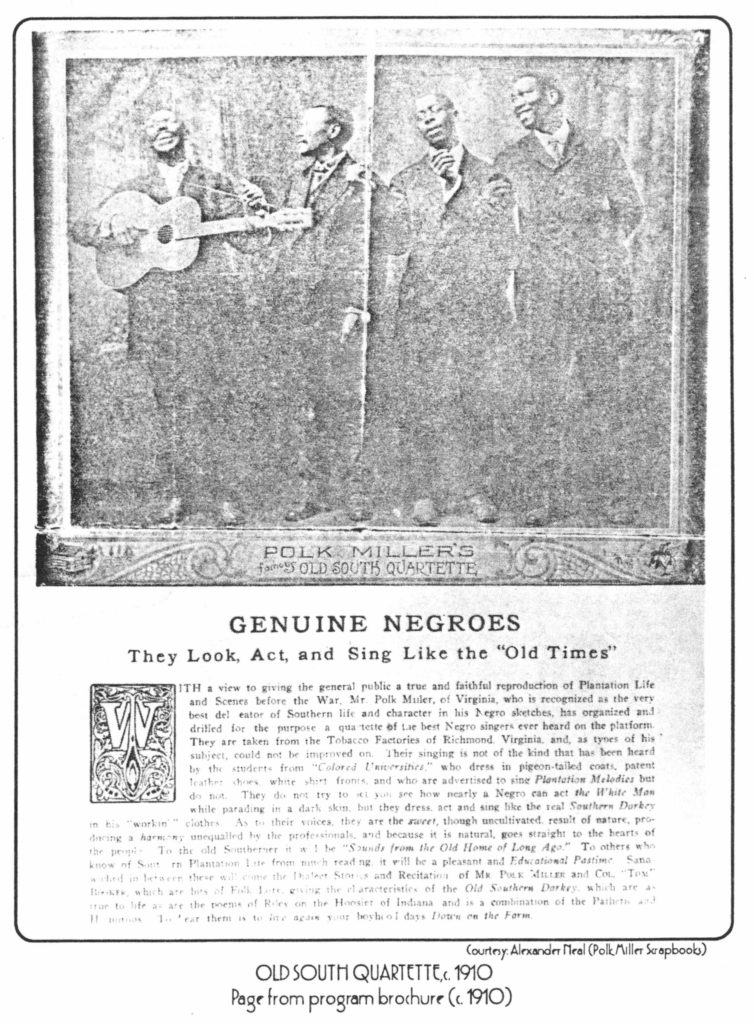
As simplistic and caricatured as that is, it is not antagonistic. Many performers were acclaimed for accurate, even “profound” impressions of Black styles. The original minstrels, who hailed from the south, learned their musicianship from Blacks; they would go on to teach their northern colleagues, who had less direct contact with the source. A White banjoist from Virginia named Ferguson, for example, was described around 1840 as “nigger all over except in color.”[x] A wannabe? Or just another White dude appreciating Black culture? Contemporary descriptions of the minstrel shows indicate that White audiences were able to identify with the black images on the stage, which included “Wit and buffoonery, music sentimental and comic, dancing stately and grotesque, pretension and simplicity, pathos and farce.”[xi]For White audiences there was always a tension between, on the one hand, the desire to dominate Blacks by reducing them to caricatures; and on the other, the desire to become one with them, to identify with them, through appreciation of their artistic expression. Appreciation vs. appropriation—such racial schizophrenia continues to this day.
The rerouting of emotional issues through caricatured characters by use of the “mask” opened the possibility of social criticism, which dealt with class as well as race questions. Stowe and Grimsted quote one exchange in which the interlocutor maintains that American society equalizes rich and poor, to which Tambo replies, “Sho, de rich gets ice in summer, and de poor gets it in winter.”[xii] The authors go on to point out that although it’s true that the stereotyped characters were buffoons, it’s also true that court jesters of old were buffoons: that was precisely the cover that allowed them to make sharp social commentary.
Many enduring elements of American show business have their roots in minstrelsy: soft-shoe dancing, vaudeville humor, political caricature, and of course, music. George Christy, of Christy’s Minstrels, was the first to bring Stephen Foster’s tunes to a wide audience. He had observed Black musicians up close at Congo Square in New Orleans, where the captured Africans were allowed to maintain African culture with drum and dance.[xiii] Minstrel Lew Dockstader got Al Jolson started in blackface, and Broadway producer George M. Cohan had his beginnings as a minstrel company manager.[xiv] Minstrel-style humor can be viewed in the Marx Brothers’ movies, and in much of stand-up comedy.
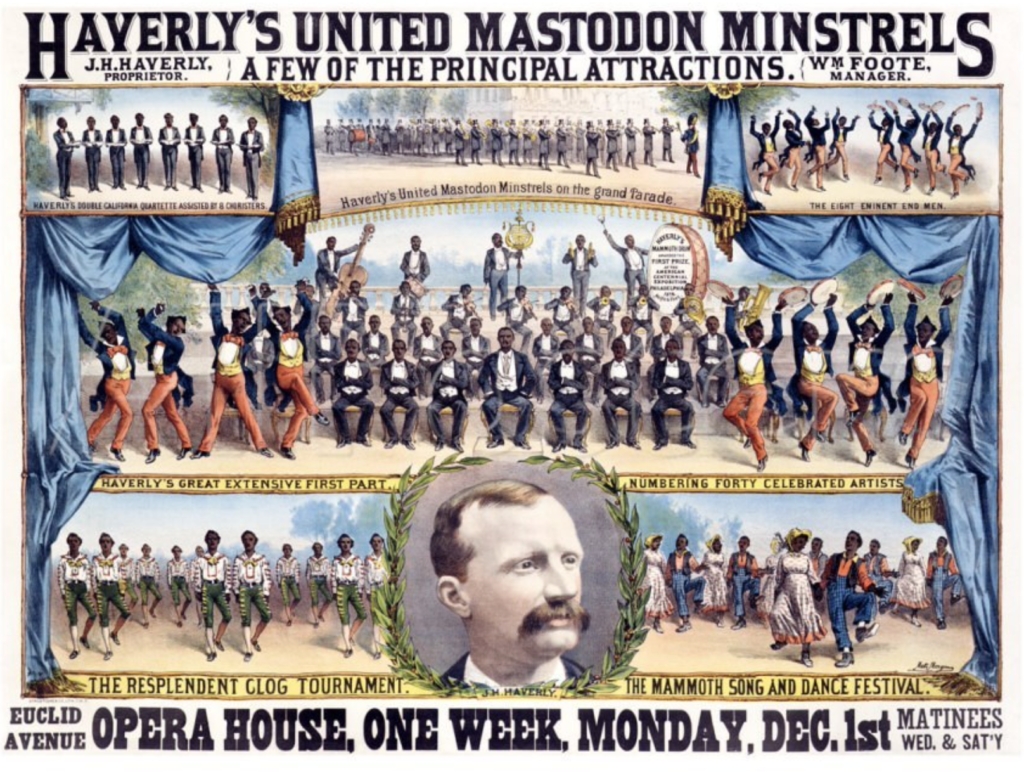
The minstrels copied songs that were originally sung by a kidnapped workforce to survive the backbreaking labor that built the South.[xv] Here we have a clear case of talking the talk without walking the walk: the White audience wants the style without the content, the gain without the pain. They receive, or seize, as Greg Tate pointed out, everything but the burden.[5] They are able to enjoy the earthy, grounded, fluid music and movement that has sprung from physical labor, without thinking about how their own lives have been softened by the labors of others. It is not unlike tourists in a tropical clime, admiring the bronze bodies of the natives who cannot afford the luxury tourist hotels. No pain, but vicarious gain.
[5] Or as Charles Keil put it, “They want the music,
but they don’t want the people.”
(City and Society, June 2002)
The blackface rendition was the dominant form of musical entertainment right up into the 20th century. Minstrel shows were often advertised, straightforwardly enough, as “imitations,” and were described by an actress of the day as “faint, feeble, impotent—in a word, pale Northern reproductions of that ineffable black conception.”[xvi] Such treatments form part of what Cecilia Conway would call the “mental terrorism” of inter-cultural relations.[xvii]
___________________________________
STEPHEN FOSTER
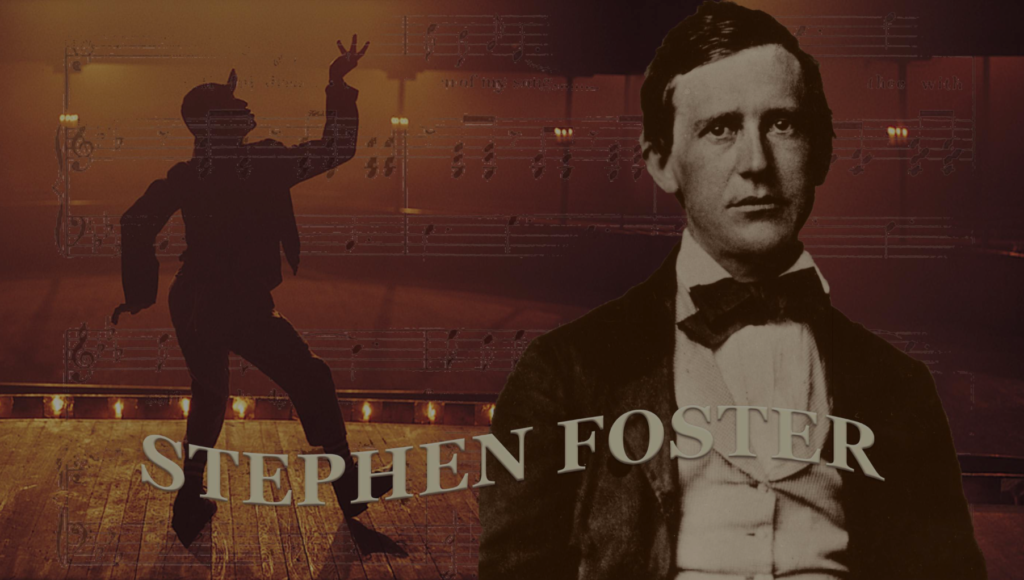
In the late slavery period we encounter the first quintessential American songwriter, Stephen Foster. Born near Pittsburgh in 1826, he frequented a Black church from age seven, escorted by one of his family’s two illegally enslaved staff (slavery being already outlawed in that section of the country). The “bound girl,” Olivia “Lieve” Pise, attended a church of “shouting colored people,” and Stephen was permanently impressed by the music. He is said to have preserved melodies he heard there in his “Hard Times Come Again No More” and “Oh, Boys, Carry Me ‘Long.”[xviii]
There was a large Black community in Pittsburgh and an underground railroad station, and Foster came in contact with freedmen, escaped bondswomen, and their families, along with his family’s “own.” He became a star performer in a childhood theatre company with his friends, singing “Zip Coon,” “Long-tailed Blue,” and “Jim Crow.”[xix],[6] While still a child, Foster saw “Daddy” Rice perform. Later he submitted songs to him, and they became friends.[xx]
[6] All three songs have roots in Irish or Scottish folksongs,
filtered through enslaved singers and minstrel showmen.
As a young man, Foster lived in Cincinnati, where he heard Black stevedores singing as they loaded boats on the Mississippi. He was supposed to be working a day job at his brother’s warehouse, but biographer John Tasker Howard tells us
[H]is heart was not in his work. He was more interested in the Negro roustabouts who sang and danced on the nearby river wharves.[xxi]
He went on to a smashing career in songwriting, his works being featured by major minstrel companies. His hits included “Oh! Susanna,” “The Old Folks at Home (Swannee River),” “My Old Kentucky Home,” “Old Black Joe,” and “Camptown Races.”
♬SUBSTITUTION: Compare “Camptown” with the Spiritual “Roll, Jordan Roll.” Was one substituted for the other?
Foster originally published his “Ethiopian” or “Plantation” tunes under a pseudonym, thinking they would detract from his reputation as a ballad-writer of such successes as “Jeanie With the Light Brown Hair.” Eventually he realized what a hit he was making with the less reputable style, and reclaimed his authorship.[xxii]
Foster engaged in some considerable struggle over the content and use of his work. He gradually eliminated demeaning dialect and offensive words from his songs, and changed their generic title from “Ethiopian Melodies” to “Plantation Melodies.” He penned realistic lyrics showing the harshness of the subjugated life, eschewed insulting caricatures on his sheet music covers, and tried to elevate the tone of the genre so that it might be more generally accepted. All of this was rather unusual in the 1840s minstrel world. He sold one song to Daddy Rice—”Long-Ago Day”—that was never heard because, according to Foster, a Rice colleague said it was a bit anti-slavery and would be rejected in the South.[xxiii] His efforts at social-musical uplift are little known because of his family’s ties to the slave-ocracy[7] and a brother who destroyed much evidence of Stephen’s deviance in the course of executing the estate.[xxiv]
[7] Foster’s father was a Democrat – the party of slavery –
and one of his sisters married a brother of James Buchanan,
the last Democratic President under slavery.
Because of the subject matter as well as the style of his work, Foster’s career is a matchless example of the centrality not only of Black musical influence, but of the race question in general to life in the United States. Brilliant songwriter he was, no question, but there always remains the matter of Blacknowledgements; J.K. Kennard in Knickerbocker Magazine (1845) noted of singing bonds(wo)men:
Let one of them, in the swamps of Carolina, compose a new song, and it no sooner reaches the ear of a white amateur, than it is written down, amended (that is, almost spoilt), printed, and then put upon a course of rapid dissemination, to cease only with the utmost bounds of Anglo-Saxondom, perhaps with the world. Meanwhile, the poor author digs away with his hoe, utterly ignorant of his greatness.[xxv]
These comments were, it is said, satire. Kennard apparently was less than jazzed by the works of untutored swamp songsters. Despite this disdain, the point intrigues. Alain Locke would later compare Foster to Joel Chandler Harris and his relationship (through Uncle Remus) to Black storytelling:
Both watered the original down just enough to give it the touch of universality, and yet not enough to destroy entirely its unique folk flavor…the sentimental side of the plantation legend wormed its way into the heart of America for better or worse, mostly worse.[xxvi]
And as Rod Stewart would point out a bit later, “There are a lot of colored guys who can sing me off the stage. But half the battle is selling it, not singing it. It’s the image, not what you sing.”[xxvii] Stewart’s words ring true, as do Kennard’s, despite being a poorly-informed satire against those who championed the Black origins of minstrel style.[8]
[8] Ostendorf (1979, 584) says
“the author half-believes what he parodies”;
Lott (1991, 236) speaks of him lampooning
“Young Americans’ quest for a national art”
through Black music as portrayed in minstrelsy.
_______________________________________
JUBA
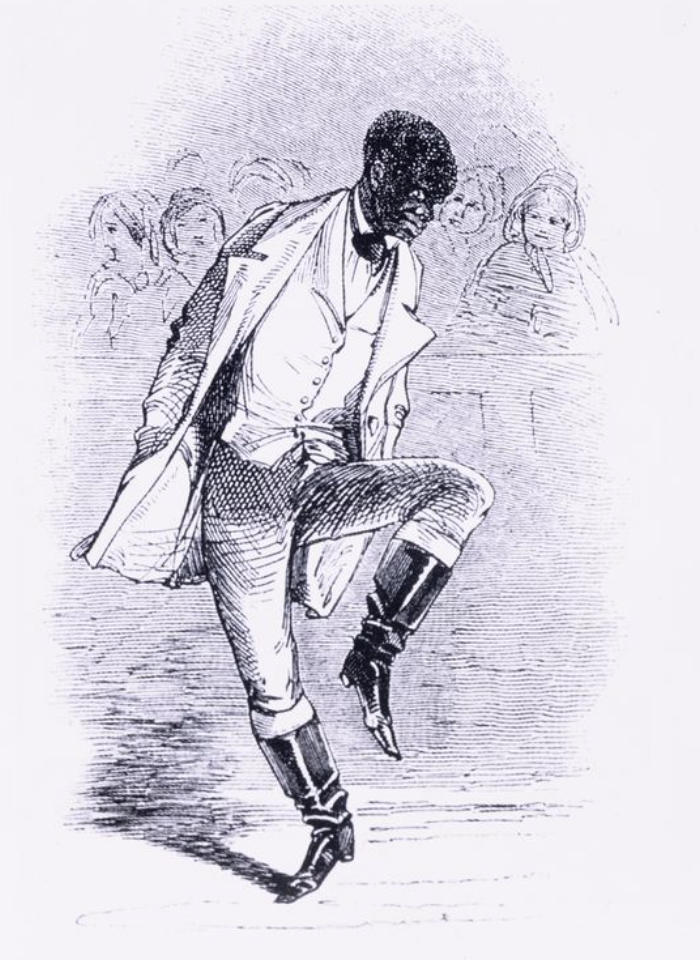
In the minstrel tradition, the real thing was never enough—or maybe it was a bit too much—so when Blacks themselves entered the field, even they had to black up, lest they be taken too seriously as, let us say, people. A notable example was Rhode Island’s William Henry Lane, who danced under the name of Juba.[9] He outdid all the other dancers, Black and White alike, and was hired by P.T. Barnum around 1841. Charles Dickens described Juba’s dancing thus:
Single shuffle, double shuffle, cut and cross-cut, snapping his fingers, rolling his eyes, turning in his knees, presenting the backs of his legs in front, spinning about on his toes and heels like nothing but the man’s fingers on the tambourine…[He dances] with two left legs, two right legs, two wooden legs, two wire legs, two spring legs, all sorts of legs and no legs…he finishes by leaping gloriously on the bar-counter and calling for something to drink…[xxviii],[10]
[9] “Patting Juba” was already a practice at least from the 1820s.
Epstein & Sands in Burnim and Maultsby, 37.
[10] Robert Farris Thompson compares this to similar steps
seen in Argentina in the 1800s, among people of similar origin
in the Kongo kingdom (Thompson, 86.)
Only one problem:
“[H]e was a genuine negro; and there was not an audience in America that would not have resented, in a very energetic fashion, the insult of being asked to look at the dancing of a real negro…”[xxix]
Barnum blacked him up, topped him off with a wig, and presented him as an excellent White imitation of a Black dancer. This particular form of debasement didn’t last long; he was soon receiving top billing on his own, in theaters where only Whites had trod the boards before Juba. Advertisements for his shows promised he would imitate the principal dancers of the day—those who had imitated him—and then offer “an imitation of himself.” The single person most credited with the development of tap dance, Juba took some inspiration from White Appalachian clogging– itself influenced by African American dancing—and Scottish dances known for a kind of syncopation called the “Scottish snap.”[xxx] He also got a lot of steps from Jim Lowe, a Black saloon dancer who remained on the margins of show biz.[xxxi]
White minstrel dancer John Diamond challenged “any other white person” to dance competitions, circumventing a pointless meeting with his master.[xxxii]
_____________________________________
Minstrelsy disturbed not only those who were the targets of its insults but also those who saw Black culture gaining in popularity through these entertainments. James K. Kennard wrote in 1845 of the “Jim Crows, the Zip Coons, and the Dandy Jims, who have electrified the world,”[xxxiii] fearing that Black style would swamp European culture. For Kennard and others, the great fear was the “blackening of America.”[xxxiv] As Kennard agonized, minstrel man Joel Sweeney would nightly “steal off to some Negro hut to hear the darkeys sing and see them dance.” He had learned banjo as a child from the imprisoned workers on his family plantation in Virginia. He was credited as the man to “distill the native musical genius of the American Negro into…an art form.”[xxxv]
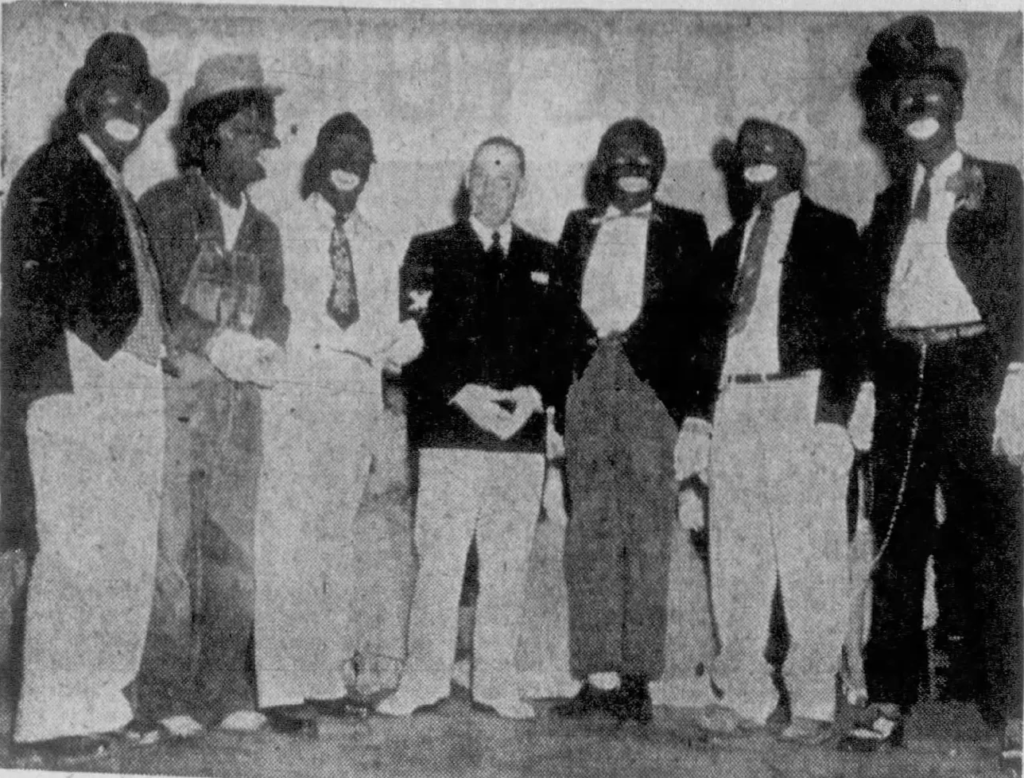
The work of the minstrels spread African-American music, in a caricatured form, to Whites throughout the country. The minstrel shows, caricature and insult though they were, paved the way for later successes by Blacks themselves. They were the nation’s major form of entertainment for many decades. Eventually there would be minstrels without blackface, and even mixed-race groups: In 1848 the Ethiopian Serenaders, a group of three White and three Black minstrels, dropped their blackface, and 1893 saw a tour by The Forty Whites and Thirty Blacks. African American troupes came to the fore in the 1860s, putting more emphasis on music and amusements than on insults and denigration, though they still expended artistic energy imitating the imitations of themselves. The Georgia Minstrels formed in 1865, followed in 1882 by Callender’s Consolidated Spectacular Colored Minstrels. James Bland, a New Yorker of Black, White, and indigenous heritage, wrote “Oh, Dem Golden Slippers” and “Carry Me Back to Old Virginny.” Trouper Sam Lucas joined forces with non-minstrel singers to produce musicals like Out of Bondage and The Underground Railroad.
Much of our entertainment today is a more genteel version of minstrelsy: Whites acting, singing and dancing Black, but without the blackface.[11] Whites continue to use and enjoy Black styles like so much rubber, spice, petroleum or any other resource. And the appropriation continues to soften up the White populace for the eventual arrival of the original article. It’s not justice, it’s just cultural trickle down. Or up. It’s a combination of racial insult with racial envy, a “peculiarly American structure of racial feeling”[xxxvi] that was first expressed artistically in minstrelsy. The envy was summed up eloquently in an African-American version of “Jim Crow” from 1833:
[11] One notable but little-noted exception was Bonnie Bramlett,
who, before her brief stardom in the “White soul” duo of
Delaney and Bonnie in the late sixties,
performed as an Ikette in Ike Turner’s backup trio –
in blackface. (Kiersh, 172.)
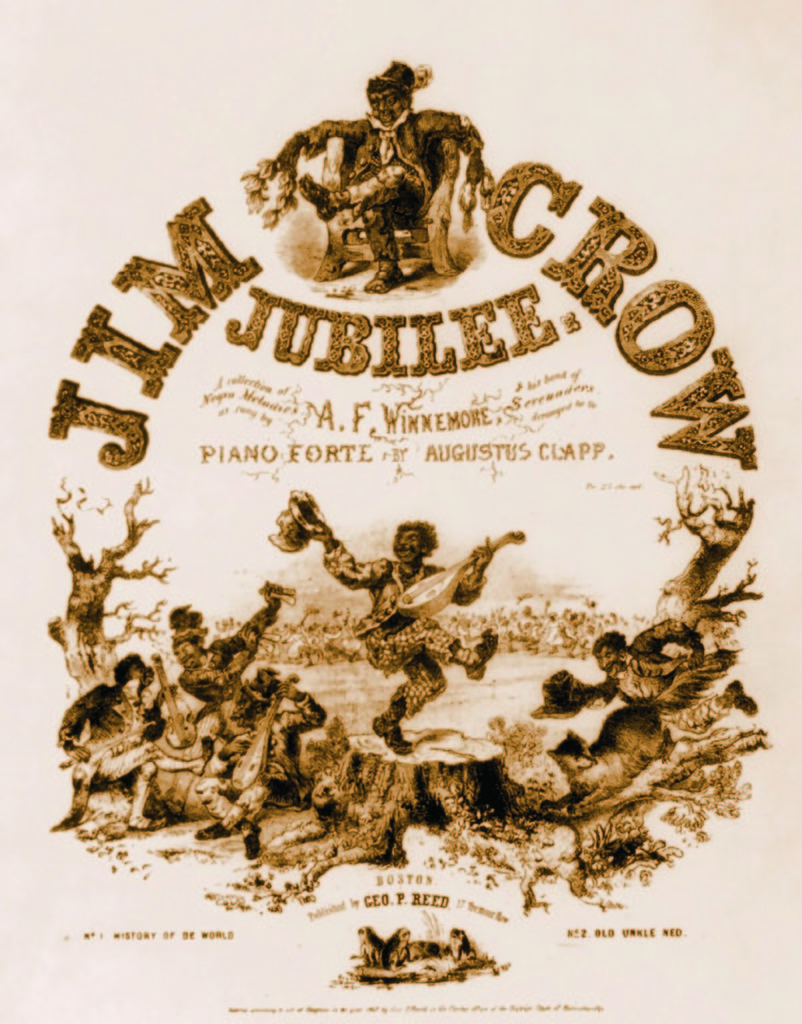
I’m so glad dat I’m a niggar,
And don’t you wish you was too
For den you’d gain popularity,
By jumping Jim Crow.
Now my brudder niggars
I do not think it right,
Dat you should laugh at dem
Who happen to be white.
Kase it dar misfortune,
And dey’d spend ebery dollar,
If dey only could be
Gentlemen ob colour.[xxxvii]
[i]Reported by Lafcadio Hearn, cited in Ralph Ellison 1964.
[ii]Ewen, 25.
[iii] Clarke, 44.
[iv] Mary Newton Stanard 1917, 136-37.
[v] Rublowsky 1971, 100.
[vi] Stowe and Grimsted, 84.
[vii] Clarke, 24.
[viii] ibid., 92.
[ix] Nathan Huggins, quoted in Stowe and Grimsted, 81.
[x] Nathan 1962, 110, cited in Conway 2003, 155.
[xi] ibid., 82.
[xii] ibid., 87.
[xiii] Clarke, 23.
[xiv] Spitzer, The Saturday Evening Post.
[xv] Lomax 1960, p 494, 514.
[xvi] Frances Ann Kemble, Journal of a Residence on a Georgia Plantation in 1838-1839, 1863, reprinted Chicago, 1969; 96, quoted in Lott, 1991, 230.
[xvii] Conway 1995, 117.
[xviii] Morrison Foster, Biography, Songs and Musical Compositions of Stephen C. Foster, Pittsburgh, 1896. Quoted in Howard, 83.
[xix] Howard, 83.
[xx] Howard, 125.
[xxi] Howard, 1.
[xxii] Ewen, 42-45.
[xxiii] Howard, 128.
[xxiv] Root, American Music Research Center Journal.
[xxv] In Clarke, 23.
[xxvi] Locke 1936, 47-48.
[xxvii] Jefferson, Harper’s Magazine, 45.
[xxviii] Dickens, 1842/1957, 91-92.
[xxix] Thomas Low Nichols, Forty Years of American Life, London, 1864, 369; quoted in Lott 1991, 227-28.
[xxx] Martin, ibid., 30.
[xxxi] Conway 1995, 94.
[xxxii] Conway 1995, 95.
[xxxiii] James K. Kennard, Jr., 1845, 332.
[xxxiv] Berndt Ostendorf, Black Literature in White America, 67, quoted in Lott, 1991, 236.
[xxxv]Conway 1995, 105, 109.
[xxxvi] Lott 1991, 227.
[xxxvii] Quoted in Dennison, 54.
